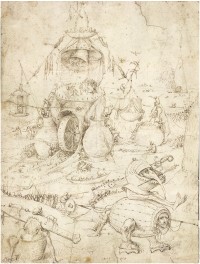 A drawing previously thought to have been made by an assistant in the workshop of medieval Dutch artist Hieronymus Bosch has been authenticated as a piece by the master himself. Infernal Landscape is a little-known drawing first emerged in 2003 when the anonymous owner sold it auction to an equally anonymous buyer. It has been squirreled away in a private collection since the sale. The Bosch Research and Conservation Project (BRCP), an international art history study that has been researching, analyzing and documenting the oeuvre of the medieval master since 2010 in anticipation of the 500th anniversary of Bosch’s death this year, were able to examine the drawing before its first public exhibition this year in honor of the anniversary.
A drawing previously thought to have been made by an assistant in the workshop of medieval Dutch artist Hieronymus Bosch has been authenticated as a piece by the master himself. Infernal Landscape is a little-known drawing first emerged in 2003 when the anonymous owner sold it auction to an equally anonymous buyer. It has been squirreled away in a private collection since the sale. The Bosch Research and Conservation Project (BRCP), an international art history study that has been researching, analyzing and documenting the oeuvre of the medieval master since 2010 in anticipation of the 500th anniversary of Bosch’s death this year, were able to examine the drawing before its first public exhibition this year in honor of the anniversary.
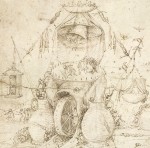 The drawing shows a chaotic, scary, monstrous hell where the souls of the damned are caught in a large fishing net rigged up to a water wheel in the maw of a hellbeast. Some are condemned to act as clappers for giant bells, others cluster in groups while fantastical creatures devour, torture and abuse them. Naked people are made to straddle the blade of a huge knife in the mouth of a giant in a basket. It’s the kind of scene Bosch is best known for, reminiscent of the Hell panel in The Garden of Earthly Delights triptych.
The drawing shows a chaotic, scary, monstrous hell where the souls of the damned are caught in a large fishing net rigged up to a water wheel in the maw of a hellbeast. Some are condemned to act as clappers for giant bells, others cluster in groups while fantastical creatures devour, torture and abuse them. Naked people are made to straddle the blade of a huge knife in the mouth of a giant in a basket. It’s the kind of scene Bosch is best known for, reminiscent of the Hell panel in The Garden of Earthly Delights triptych.
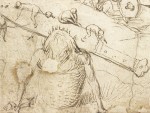 In fact, it was its very Boschishness which initially led scholars to think it was the work of an assistant. They thought it was a pastiche, a copy of several Bosch figures made by a student. The BRCP used state-of-the-art technology to analyze the drawing. They examined it with infrared reflectography, ultra high-resolution macrophotography in both infrared and visible light, X-radiography and microscopy. They tested the paper, handwriting and inks, comparing them to known Bosch drawings from major European collections. The team found that some of the figures in the Infernal Landscape match underdrawings in paintings. There is a similar fellow in a basket underneath The Garden of Earthly Delights, even though Bosch chose not to include him in the final painting.
In fact, it was its very Boschishness which initially led scholars to think it was the work of an assistant. They thought it was a pastiche, a copy of several Bosch figures made by a student. The BRCP used state-of-the-art technology to analyze the drawing. They examined it with infrared reflectography, ultra high-resolution macrophotography in both infrared and visible light, X-radiography and microscopy. They tested the paper, handwriting and inks, comparing them to known Bosch drawings from major European collections. The team found that some of the figures in the Infernal Landscape match underdrawings in paintings. There is a similar fellow in a basket underneath The Garden of Earthly Delights, even though Bosch chose not to include him in the final painting.
“It’s not just a ‘successful pastiche’, as some have called it. I’ve seen quite a few of these, and 99% of the time, they are not very inspiring,” [BRCP project coordinator Matthijs] Ilsink says. “This one is very, very good.” He says the argument that the work is “too Bosch to be by Bosch” does not hold water, given the fact that other, equally “Boschian” drawings — including Tree Man (around 1505) in Vienna’s Albertina — are considered to be authentic works. “You can’t blame Bosch for being too Bosch,” he says. […]
Ilsink says that Bosch often changed his mind as he worked, so his paintings have a lot of overpaint and underdrawings. “Someone creating a pastiche of his works wouldn’t have access to these earlier versions,” Ilsink says. He admits that some might argue that Infernal Landscape was made in the artist’s workshop, but he does not believe this to be the case.
The drawing is an important addition to Hieronymus Bosch’s body of work. It’s large in size and so richly chaotic that it gives art historians a glimpse of Bosch’s additive, free-association approach to composition.
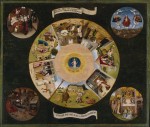 The BRCP’s research has also gone the other way. The team discovered that two paintings attributed to Bosch, Christ Carrying the Cross and The Seven Deadly Sins are likely the work of followers, not the artist. Macrophotography, x-radiography and infrared reflectography revealed that Christ Carrying the Cross that it was produced after 1525, nine years after Bosch’s death, and the painting style is dissimilar enough to make it unlikely that it was even made in his workshop. The Seven Deadly Sins was exposed by its underdrawings and overall quality as definitely not the work of Bosch himself, although it’s possible that it was made in the family workshop.
The BRCP’s research has also gone the other way. The team discovered that two paintings attributed to Bosch, Christ Carrying the Cross and The Seven Deadly Sins are likely the work of followers, not the artist. Macrophotography, x-radiography and infrared reflectography revealed that Christ Carrying the Cross that it was produced after 1525, nine years after Bosch’s death, and the painting style is dissimilar enough to make it unlikely that it was even made in his workshop. The Seven Deadly Sins was exposed by its underdrawings and overall quality as definitely not the work of Bosch himself, although it’s possible that it was made in the family workshop.
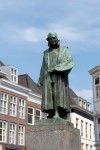 The Dutch city of ‘s-Hertogenbosch, commonly referred to as Den Bosch, birthplace, home and workplace of Hieronymus Bosch, is celebrating the anniversary year with a great many parades, concerts, games, theatricals, art shows, lectures and, for the December finale, “the lighting of the Bosch beast” in the city center which I haven’t been able to find a precise description of but sounds like the greatest Burning Man ever. The Noordbrabants Museum will hold a major exhibition of Bosch’s work. Hieronymus Bosch – Visions of Genius brings together masterpieces from top institutions in Europe and America, including the Metropolitan Museum of Art in New York, the National
The Dutch city of ‘s-Hertogenbosch, commonly referred to as Den Bosch, birthplace, home and workplace of Hieronymus Bosch, is celebrating the anniversary year with a great many parades, concerts, games, theatricals, art shows, lectures and, for the December finale, “the lighting of the Bosch beast” in the city center which I haven’t been able to find a precise description of but sounds like the greatest Burning Man ever. The Noordbrabants Museum will hold a major exhibition of Bosch’s work. Hieronymus Bosch – Visions of Genius brings together masterpieces from top institutions in Europe and America, including the Metropolitan Museum of Art in New York, the National 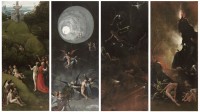 Gallery of Art in Washington, D.C., the Prado in Madrid, the Louvre in Paris, the Gallerie dell’Accademia in Venice and the Museum Boijmans Van Beuningen in Rotterdam. For the first time, a majority of Bosch’s works will be together on public display in the city where they were painted. Artworks include world-famous pieces like the Haywain Triptych and the Ship of Fools, as well as virtually unknown works like the newly authenticated Infernal Landscape drawing and 12 panels recently restored by the Getty Foundation’s Panel Paintings Initiative which have never been on view to the public before. The exhibition runs from February 13th through May 8th, 2016.
Gallery of Art in Washington, D.C., the Prado in Madrid, the Louvre in Paris, the Gallerie dell’Accademia in Venice and the Museum Boijmans Van Beuningen in Rotterdam. For the first time, a majority of Bosch’s works will be together on public display in the city where they were painted. Artworks include world-famous pieces like the Haywain Triptych and the Ship of Fools, as well as virtually unknown works like the newly authenticated Infernal Landscape drawing and 12 panels recently restored by the Getty Foundation’s Panel Paintings Initiative which have never been on view to the public before. The exhibition runs from February 13th through May 8th, 2016.
 Den Bosch was founded in the 12th century a fortress city and much of the historic center has survived intact, including the complete medieval ramparts that encircle the old town. It was spared from destruction in World War II and spared from even worse destruction by well-meaning modernizers after the war thanks to the city council’s quickly declaring the entire old city a protected historical townscape before the first rampart could be felled or the first canal filled. That means if you take one of the special Bosch Experience tours available from March to November of this year, you will be seeing things he actually saw, walking the same winding roads he walked, visit the same places he worked and lived.
Den Bosch was founded in the 12th century a fortress city and much of the historic center has survived intact, including the complete medieval ramparts that encircle the old town. It was spared from destruction in World War II and spared from even worse destruction by well-meaning modernizers after the war thanks to the city council’s quickly declaring the entire old city a protected historical townscape before the first rampart could be felled or the first canal filled. That means if you take one of the special Bosch Experience tours available from March to November of this year, you will be seeing things he actually saw, walking the same winding roads he walked, visit the same places he worked and lived.
[youtube=https://youtu.be/CxuhuTtXHfg&w=430]
All of the research and analysis the BRCP has done over the past six years will be published in a two-volume monograph later this month. There will also be a website, funded by the Getty Foundation, where all the BRCP’s research and images will be available for our rapt perusal. It’s set to launch before the opening of the Noordbrabants Museum exhibition but there’s no url yet. I’ll update when the site goes live.